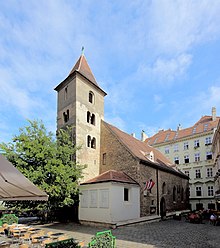St. Rupert's Church, Vienna
| St. Rupert's Church | |
|---|---|

St. Rupert's Church in Vienna, Austria
|
|
| Basic information | |
| Location | Vienna, Austria |
| Geographic coordinates | 48°12′43″N 16°22′28″E / 48.211944°N 16.374444°ECoordinates: 48°12′43″N 16°22′28″E / 48.211944°N 16.374444°E |
| Affiliation | Catholic Church |
| State | Vienna |
| Ecclesiastical or organizational status | Active |
| Leadership | P. Hans Brandl, SJ |
| Website | www |
| Architectural description | |
| Architectural type | Church |
| Architectural style | Romanesque, Baroque |
| Completed | 740 |
| Specifications | |
| Direction of façade | NWbW |
| Capacity | 100 |
| Length | 27 m (88.6 ft) |
| Width | 13 m (42.7 ft) |
St. Rupert's Church (German: Ruprechtskirche) is a Romanesque church in Vienna, Austria. Traditionally considered to be the oldest church in the city, St. Rupert's Church is dedicated to Saint Rupert of Salzburg, patron saint of the salt merchants of Vienna. The church is located in one of the oldest parts of the city, the section of the Roman Vindobona.
There is currently some debate whether the Ruprechtskirche is truly the oldest church in Vienna. Discoveries of old foundations under the St. Peter's Church and old graves under the St. Stephen's Cathedral have disputed the certainty of this label.
According to legend, it was founded by Cunald and Gisalrich, companions of Rupert during his occupation of the seat of bishop of Salzburg. However, because Salzburg had influence over religious issues in Vienna between 796 and 829, it is more probable that it was founded in this period.
The first reference in historical documentation is in a document of 1200 when Duke Heinrich II Jasomirgott describes a gift to the Schottenstift church. The document also mentions the Ruprechtskirche, which is labeled the oldest in the city.
After the destruction of the Roman settlement, the core part of the city grew in the area near the church. It was the seat of the religious administration before that function was transferred to the Stephansdom in 1147.
During the Middle Ages, the church was the seat of the Salt Office (Salzamt), which distributed salt to individual buyers and ensured its quality. The church overlooks the jetty of the salt merchants on the Danube channel.
The ivy-covered church has been rebuilt and altered many times in its history. In 1276, it was damaged by fire and modified. The choir dates from the 13th century, while the southern nave dates from the 15th century. In 1622, it was redecorated in Baroque style. It was also somewhat damaged by shellfire during World War II and affected by the demolition of the nearby ruins of another building. In the middle of the apse, there are two Romanesque stained-glass windows.
...
Wikipedia
